

Noyhauser
-
Posts
1581 -
Joined
-
Last visited
Content Type
Profiles
Forums
Events
Gallery
Posts posted by Noyhauser
-
-
Currently I'm just continuing to let things sit. (actually stripped and repainted one small part that I was able, but only because the paint got a nick in it---uncured paint isn't very durable) Maybe another month will do something, but I'm thinking more like 2 or 3 months for noticeable improvement, if any will occur. (I'm pretty sure some segments have dried for over a month now)
I could use a hair dryer or something and heat it up a little, but I doubt "30 secs of being warm" would do more than "3 weeks of being room temp". Can't get it hot, some parts of it are the type of plastic that'll "curl" when hot, and never un-curl. (and I don't plant to experiment/test and find out too late that a "safe" part wasn't)
While I hope it does work out, I've been in your situation before with generic paints and its not been a successful one. If its not dried in a month, then its unlikely to dry (and more likely to get worse as its a chemical reaction between the paint and something underneath.)
On a related note of a different paint---should I put a clearcoat over an acrylic paint that dries, but instantly liquifies upon contact with water? Very strange--a general rule of acrylics is that "contact with their thinners will not reliquify them"---especially when their thinner is pure water. But this one---contact with almost any moisture (other paints, saliva, etc) will make the paint just come right off. I'm hoping a lacquer clear from Tamiya would be non-aqueous enough to not affect it.There are two parts to your question. Some Acrylic thinners will react to dried paint: windex or alcohol being the top two. Water should not and I've never seen what you're describing for dried paints. I've found that future does react to dried paints, albeit minimally. It may also be due to the fact that it wasn't completely dry. Consequently, I'd be very careful in applying a glosscoat to it. However if you're using a lacquer glosscoat like Tamiya I'm almost sure you're going to get a reaction, as lacquers will eat into any acrylics faster than it can dry. If you try to brush it on it will streak the colours, while airbrush will leach the colors over the surface. There are airbrush techniques that might be able to mitigate this. I personally use Modelmasters acryl glosscoat for a first glosscoat because its generally non-reactive and dries really fast (30 minutes versus 24 hours for future.) It has orangepeel problems, but it lays a good, thin base, for later gloss coats of future.
The best might be to do a test piece with the paint on a piece of scrap styrene, wait a week, test the paints durability (in regards to reactivity to water) and then spray on lacquer and other glosses you might have. That will give you an idea of where to go.
-
Alright, so I just went through the last episode of Macross Plus again trying to get a good look at the Earth and there doesn't seem to be any vegetation anywhere. All the shots of the planet when Isamu is entering the atmosphere are blue and brown. This would seem to follow the DYRL story more than the tv series since in the tv series they at least mentioned that some forests had survived.
Using Macross City's status in macross plus as a indication of the planet's condition is somewhat misleading. If Macross city is somewhere near Alaska and thus approaching northern latitudes (where temperatures goes through significant extremes and can only support hardy plantlife in a VERY delicate ecosystem) then regeneration may take significantly longer than in more temperate regions. Its quite possible that areas south of the 49th parallel have experienced significant regrowth and rehabilitation by 2040 and beyond.
-
Awesome! Thanks for the tips. Looks like I will be saving $12! That is good. In the long run I will save even more. Then I can buy more of the other supplies I need.
Don't discount the Tamiya product. I agree that its a bit overkill for large undetailed panels, but the product (regular and fine) are excellent as a primer for regular modeling. It settles well and does not wash out details, which is critical if you're building an aircraft model.
-
Nice photos joseph.
A new article from the NYT on the U2... thought you might be interested.
-
So...I'm finally catching up on Macross Frontier...and I'm loving it....but I'm a little disapointed with the models I can find. Looks like Bandai has a nice selection of 1/72 variables...but I've sworn off variable models. To hard (for me at least) to make them sturdy enough for the finish and build to handle transformation more then a few times. Anyone know if there is any chance of a Hasegawa release of a single mode kit. (seems unlikely with Bandai owning the rights for 1/72) Other decent options? (I started watching for resins, but I'm not catching much)
I'm with you and the others... I'd consider doing a battroid-only build of the VF-25 but the accuracy issues and breaklines in the fighter version turns me off that model. I've seen a couple of resin VF-171s around which look decent, except they don't have any cockpits.I suspect that in couple of years the resin industry will come up with something... we got plenty of VF-1s in the 1990s even though there were tons of kits out there. You saw WAVE kits being put out for Macross 7 despite bandai owning the license... so there is some hope (unless they have an exclusive contract and are unwilling to sell rights further... which I doubt given Bandai's history.)
I'm with you on this one buddy, transforming kits seem pretty pointless to me. I have a number of these but I plan on building them as static fighter kits. If I ever get around to building them I'll post.I think it's been like 5 years since I've finished a model
 I'm slowly working on one though.
I'm slowly working on one though.I'm sure you'll do a great job... its like riding a bike, except that if you take your time you can always make up for mistakes.
-
And they are talking about bringing back COIN aircraft, and the two top competitors are the AT-6B and a new OV-10X. As much neither one, nor the F-35, can really do the job of the A-10 as well as the A-10, I would much prefere to see the OV-10X in the role if they can't, by some miracle, find a way to start building a new model A-10.
Boeing has indicated that it will offer a new OV-10 for the LAAR program. Don't forget the Piper PA-48 Enforcer also, the P-51 follow-on with a turboprop.. though it probably will be cut because its a single seat aircraft. In any case, the Light Attack Aircraft program isn't really intended to be a A-10 replacement; its can't operate in a high-intensity battlefield or with any significant SAM threat. Its a COIN aircraft, designed to meet a mission profile that hasn't been filled in over 15 years. The LAAR's main role is more for observation and FAC, with attack being more of a secondary role. The A-10 is the opposite, its a pure attacker that can observe and control to a very limited fashion. The A-10 isn't really good at the latter, it moves too fast and is a single seat aircraft. Thats part of the problem with it even in CAS in a COIN environment; you've seen quite a bit of Fraticide incidents because of mistaken identities. The LAAR program will provide an aircraft that can deliver some ordinance in a pinch, but really would defer to fast movers like A-10s and Reapers to deliver large quantities.
Edit: I found the Request for Proposals page... these are the requirements:
LAAR operations will integrate with traditional Command and Control (C2) concepts and organizations and existing joint Tactics, Techniques and Procedures (TTPs). Mission planning will require access to theater air tasking order (ATO) and airspace control order (ACO) dissemination networks. LAAR may be tasked as part of a joint team and will require communication capabilities to coordinate with supported and/or supporting units. LAAR platforms will employ a modular structure capable of interfacing with multiple weapons and sensors to tailor configuration to tasking and having robust, integrated sensors used to find, fix, track, and target within a single asset. For LAAR platforms, aerial gunnery and precision weapons will provide the ability to engage targets quickly, thus reducing the sensor-to-shooter timeline. LAAR platforms will have the ability to coordinate fires directly with supported ground units through voice, video, and datalinks with other assets to create synergies and minimize fratricide.
Basically it sounds alot like the Reaper, but with humans inside to provide greater synergies in operations.
-
If you want to take out a bunch of modern SAM sites using HARMs, I see a few issues:
1. F-35 can't carry it internally----first day high-risk missions are where stealth is needed the most.
2. F-16's only carry 2, and aren't stealthy in the slightest.
3. Super Hornets can carry 4, but will seriously lack loiter time, which is often required for HARM deployment as the SAM sites aren't going to be active 24/7.
A quick check at F-16.net on this very issue suggested F-22's at high speed and high alt, using SDB's---and that actually sounds like a good idea--I doubt even the most advanced SAM will have much success trying to shoot down something going nearly Mach 2 at 60,000ft. Question is would the USAF risk them, especially in a "first day" situation
See I think there is waay too much focus on one aircraft in SEAD, when since the first Gulf War its been carried out by huge strike packages that include dozens if not a hundred aircraft working as part of a team. Stealth aircraft play one part, and not that significant when you have very good stand off weapon, UAVs and a whole new generation of Jamming equipment. Nobody sends stealth aircraft alone to do SEAD. You need dedicated SEAD aircraft, which is another area of growth for the US military. It didn't receive much attention but the last budget saw the Navy receive another four Growler squadrons, in addition to the ten already projected. In addition to the Growler, the military is investing in a new set of Jammers as a follow on to the ALQ-99 generation. These include directed energy system that will adaptively jam a capability.
UAVs are a critical part of this strategy because they can be sent into high risk areas to identify threats for manned aircraft operating outside of the line of fire. During the 2003 invasion of iraq, the USAF sent stripped down Predators to either identify emplacements, or provoke them so that they could be targeted. So effective was these operations that the USAF reconsidered its cancellation of the MALD drones, and prompted Raytheon to restart development. Its designed to provoke SAMs to fire, where they can be identified and destroyed. If an opponent doesn't use their SAMs, then other UCAVs like Reapers or their follow-ons the X-45/47, can independently search out silent emplacements and kill them. Thats something which didn't exist before because you didn't want to send aircraft and men into harms' way. Its a far more dangerous for air defences when they are up against a capability that is not concerned for its own existence.
With the proliferation of electronic jammers, there isn't much need for "shooters" with High stealth with F-22s. The 16CJ right now plays that role sufficiently. Launching SDBs at hight is nice, but the JSOW is a pretty capable system that is purpose designed for such a role. Its highly accurate, has a range over 100km and contains significant stealth features to prevent interception. JSOW can fit into the F-35's bays as well. With the level of Jammers available the stealth capabilities of the F-35 are likely quite sufficient. Given the number of platform available, there isn't really a need for the F-22 to undertake SEAD missions.
In reality the US Military is pretty well prepared for this threat area and are pretty well ahead of any possible threat. Its not just the Americans either; after Kosovo they identified this area as an issue and have started to deploy their own countermeasures.
-
It's not just the fighters, though PAK-FA could be an issue. How about the latest and greatest that Russian SAM systems (upgraded S300 and S400) that are just as much a threat to 4th generation fighters...
Thats got little to do with the F-22's role. Its an air superiority fighter, not a deep penetration bomber, nor a SEAD platform. The US has already developed a range of responses to deal with this situation without ever resorting to deploying the F-22s... the retirement of the F-117 a few years ago should indicate to you why this isn't really the threat that its made out to be. First off the current generation of Precision Guided Munitions like the JSOW and the AGM-88E are viewed to be sufficient to deal with these threats for the foreseeable future. They provide high probability kills at extremely long ranges. Moreover these new generation of weapons allow for less of a need to undertake deep penetration missions as was the case in prior operations.
Next the USAF already has several major aircraft that can deal with the threat. This includes the EA-18G and the F-16CJ. Within five or six years you'll see the third generation of UCAVs. One the major aims is to use them to attack SAM emplacements without putting aircraft at risks at all.
-
Soooo---anyone got any links to a GOOD article on why we need more F-22's? Preferably one that's carefully read before being linked to?

Its not about the F-22, but it is about the future direction of the Air Force. Hopefully you can access it. It details how the UAV crowd has become more influential in the past few years.
-
PPS---much like the argument that the F-22 and F-35, while not having very high top speeds compared to the F-14/15, are actually "faster" in actual combat due to being able to reach top speed while fully loaded----the YF-23 has absolutely unsurpassed acceleration---I'd take that in a dogfight over top speed. (the F-15 never won a fight by being the fastest plane AFAIK---but it often does by having the best vertical acceleration and climb)
Quite possible. In reality I don't think speed mattered much at all in the competition, particularly if the actual difference was quite small.
-
GE estimated a 0.2M advantage for the -23 over the -22, in supercruise. The 2nd (faster) of the YF-23 prototypes still has nearly every speed specification classified. A lot of the YF-22 vs YF-23 speed comparisons are done using the faster of the -22's vs the slower of the -23's, which is kind of unfair...
Uh... don't you mean 0.02M advantage in supercruise with equivalent engines? I've never heard it to be as large as 0.2M. Regardless, I said as much in the first comment, but the top-end speed analysis examined the 23's mach cone. Now those figures are rough and probably puts the YF-23 above the Mach 2 as you say, but its not clear that at the top end the YF-23 is "faster" than the YF-22. I'm just saying its in dispute and probably really close (if its this close its really an insignificant factor in the government's assessment.)
As for aerodynamic analysis----how many "experts" say the SR-71 could go Mach 5 or some other equally ludicrous number? (plus, what were they working from---a 3-view line drawing? NOBODY has access to the full 3D shape of a YF-23, certainly not an accurate one)Was this really necessary to say given you agreed with most of what I said and we're both in the same boat? They looked at the mach cone, which isn't an precise figure by any means but it gives an general indication of their various advantages. I know that its rough, but its a valid point that at the top end the 23 might not be faster than the 22, or only just.
Thats really my problem with the entire YF-22/23 debate. I've seen a lot of fluff about how the 23 was such a better plane than the 22 and that politics and maintenance was the reason for the latter's selection. I don't think much of it is accurate to be honest, which is kinda my point.
-
What are the possibilities that a variant of the YF-23 is already being used in the role of the F-117 and it's just secret?
In a word... impossible. Sure there are black areas of the budget, but developing/manufacturing/maintaining an entire squadron of aircraft without any public scrutiny just can't happen. And why would they need it? Between the B-2, the F-22 and new GPS guided weaponry, there just isn't a need for a F-117 replacement.
I find it... interesting that the performance of the YF-23 apparently remains classified to this day. It seems pretty well accepted that YF-23 was significantly faster than YF-22... it's stealthy characteristics are well suited to the attack role and it could also double as a fighter. The rapid dropping of the F-22 numbers tell me it's not an economic reason, but either the USAF has something else cooking, there's some possible critical flaw in the design, etc.Reading around, I'm not sure that the YF-23 was really "faster." Someone did an aerodynamic analysis of its design and suggested the that Black widow would have a lower top end speed (1.8 for the 23 vs 2.0+ for the 22.) They suggested that the 23 probably had a higher supercruise, but it wasn't significant. As for the 23's performance remaining classified, its partly because few people actually care anymore and that it has a lot of technologies that can still be used by foreign parties.
The lack of F-22s is the result of a number of factors. One is a strategic calculation; there isn't a foreseeable need for high performance manned fighters in the next fifteen years. The real need is in counterinsurgency operations like Afghanistan and Iraq. With the deficit as high as it is, the F-22 was a ripe target to cut. Within the Office of the Secretary of Defense there has been an increasing disdain for what are described as "cold war" projects. In the past five years you saw the Commanche and the Crusader cut, with the Osprey and the F-22 seeing huge reductions.
The USAF does have something else cooking, its UCAVs programs. Reading through last year's budget, the area that received the greatest area of funding was UAV development.
-
Doesn't discount the fact that the US and India have opposing interests over the Pakistan. US and India just have some common interests now that China is rising. You will note that despite buying lots of US equipment they are also maintaining their close ties with Russia-- the PAK FA is a good example of that, if you want to talk about economic linkages between tech and aerospace companies.
What are those opposing interests? What you said was true maybe a prior to 1990 and 2000, but certainly not since September 11th. Pakistan was the stumbling block between the relationship, but no longer. Both India and the United States want a Pakistan that respects its neighbors, doesn't support terrorism or territorial aggression. Both India and the United States want resolution over Kashmir and a stable, peaceful Afghanistan. There has been a deterioration of relations between Pakistan and United States which has facilitated cooperation with India.
Moreover, buying from Russia doesn't mean the country has any sort of close political relationship. Its just a source of weapons, thats all. If France offered a new carrier to them at a reasonable cost, the Indians would jump on it. Russia also is problematic as a source of weapons. Russian equipment are often delivered late, of inferior quality, and do not come with great industrial benefits. The whole Admiral Gorshkov episode is a very good example of that; four years overdue (and counting), overcost, with inferior aircraft, and with absolutely no industrial benefits. Boeing already opened a research and development facility in Bangalore and uses Indian subcontractors extensively for a number of different areas. A few military programs here and there with Russia pales in comparison to the fundamental scale of economic cooperation between the United States and India. Finally don't discount the power of the Indian diaspora, which has facilitated expanding cooperation between the two nations. Russia doesn't enjoy anything close to that relationship.
Moving on-- how far along the developmental path is the X-47 anyway? Has it done actual carrier landings yet?First flight has been pushed back for the X-47B (after the prototype of the X-47A), but F/A-18Es already have some automation in their landing sequence (which may be expanded up to full automation soon,) and there are integration efforts with the X-47 using a surrogate aircraft.
-
Well, I am pretty impressed with the usual posters in this thread. Although my own work is considerably more pedestrian, I wanted to join in the fun.
I hate painting models...so what I have here are the projects I've been working on the last several months...all curiously in the same state of WIP. That is to say, all done except the painting and prop+canopy glueing.
I also like to build things no one else has built...which is why everything here has been modified (if you can't build a P-51 as good as the pros, build a P-51 the pros never will, that's my motto).
If you're interested in my unfinished stuff:
P-38 built upside down (no pilot/cockpit...)
P-61 with gunner hump deleted
R3C-2 built upside down (porco rosso kit, so its a modification of a modification)
modified Pfalz D-III (awaiting floats)
Ki-100 (w/ Ki-44 wings)
modified F4U corsair
modified and re-engined Br.693
Whats' pedestrian about it?!?! Seriously those are some hot looking kits, even without paint. I love the modified kits; it kinda reminds me of stuff in movies like Sky Crawlers or Wings Honnmisase. I'd be excited to see some fictional paintjobs... even if they were simply all metal.
-
Oh please. Three out of five of the next major purchases for their air force are for going to the US (P-8, C-130J, and C-17) while another one has two US built designs competing for it (F/A-18F, and F-16I for the MMCA competition), there's even rumors the Indians want to buy F-35Bs or F-35Cs for their carriers. In addition to the Cope India exercises the IAF is now a regular participant in Red Flag. India was close to Russia 25 years ago but they've moved quite a bit of distance since then.
Its probably better than that. Since 2000 there has been a sustained effort by successive administrations to improve relations between the two countries. Part of it was that Washington saw India as a ideological ally as a democracy in a region it has a large interest in. There are significant economic linkages with tech and aerospace companies. The nuclear agreement between the two countries illustrates just how deep the new relationship.
Russia was a traditional ally because of communism, but thats really gone to the wayside. It still buys equipment from Russia, but its doubtful that the relationship is anywhere as close as it is with the United States.
-
"Detailed strategic analysis indicates that the only viable strategic survival strategy now remaining for the United States is to terminate the Joint Strike Fighter program immediately, redirect freed funding to further develop the F-22 Raptor, and employ variants of the F-22 aircraft as the primary fighter aircraft for all United States and Allied TACAIR needs."
Music to my ears. I'm dubious about his analysis, though I would love to see that alternative come about instead. His most questionable premise IMO is some other country putting up 400 x SU-35's.
The PAK-FA looks cool and hopefully will lead to more F-22 but the Russians only plan 200 of these things with another 250 to India right? I'll be really surprised if the Russians meet that number. If they do, I'd like to see 2x that many F-22. All of his analysis seem to center on the USAF... what is the US Navy's plan? Stay with Super Bugs indefinitely?
Simple: the X-47. I suspect that by 2020ish you'll start seeing the first USN UAV squadrons operating from carrier decks. Thats where all the budget for development is going.
-
So, I was able to talk to Gundamhead and WM Cheng today and get a little more information. Gundamhead and WM have both built the kit and both experienced some saggaing. Gundam's display is vertical (base flat, arm pointing up 90 degrees) and his issue is a small bend in the actual clamp mechanism. This was not reinforced when I cast it...and I dont believe it is now. WM Chengs issue is more serious. He said he would post pictures, but his is off by an inch or more. His issue is compounded is the arm is extending out from the wall holding all the weight of the Valk. I'd love to see the pictures for more ideas, but I wanted to post this so anyone who gets a kit, or already has one is aware. Valkyries thicker rod idea may help...but based on what WM said it still may be a problem over the long term. WM's is a few years old now, and he said it has happened slowly over time. I think the combination of the length of the arm and the weight of the valk will just be something to be careful of.
My first thoughts for those building a kit are:
1 - Consider display position. The Arm up at 90 degrees will probably be less problematic. Adding some brass pins during build would probably make sense as well
2 - Keep your Valk as light as possible
3 - Clear bracing. I was thinking, if I build mine like WM I may add a clear acrylic rod at a 45 degree between the valk and the base. It stinks to have to do, but it may go a long way. Other bracing ideas could be a small piece of fishing line going from the valk at a 45 degree above the base.
I'm sure you all have many better ideas then I...what do you think?
Finally, as for fixing existing issues...any ideas for WM? My best bet would be to heat the resin and try to bend it back, but I honestly dont know that the paint would survive it. Anyone have a better thought here for WM?
I bought the kit off of someone selling theirs and I can see how sagging could occur at the joint. I considered all four of your points, but I think #2 is one of the most difficult but with the greatest reward. These were my thoughts where it could be applied:
#1: The area in the legs that are covered by the fastpacks.
#2: Some of the area inside of the wing joints: at very least it could be replaced by styrene stock.
#3: The area in between where of the arms where they are side by side.
#4: Carrying RMSs instead of the UMM Boxes.
#5: A general thinning of the model's interior.
I think some areas can be completely replaced by card: The underside of the back boosters, the area behind the engine exhaust, the wingroot interiors, ect. Depending on how proactive one is with my #5 I think you can remove 25~40% of its weight, I'm just uncertain as to whether it would be enough to prevent sagging. This combined with some brass reinforcement on the joint might be sufficient.
This might be my project for the summer.
-
I don't know if it will. Way back when I had a siphon feed Badger then went to brushes for convenience (I moved around alot). Then last year I first picked up an Iwata Revolution CR and loved it.... As with the Captain I find gravity feed just that much simpler to use; cleanup usually involves a bit of lacquer thinner (which cleans almost any product I use) a simple wipe of the cup on most days, then remove the needle for the night. Changing paints mid job isn't that tough; I find its more a question of good planning and estimation of the paint you use. Put just enough in for the job; do a quick clean with windex or alcohol, then put in the next paint. Easy as that. Two things I find that are useful: Iwata superlube (which I hear KY is an good substitute but I've never used it) and a proper cleaning set.
Anyway, the CR is a versatile machine; Its more robust than the normal Iwata, but still has great performance. My only beef was the lack of definition; its great for painting large areas but not for small things like exhaust lines, cordite burns, and oil stains. So I picked up a used HP-B plus, its an extremely fine airbrush. I only use it for like 10% of what I do, but its really useful in those places. And it is delicate. I clumsily dropped the nozzle a few months ago and it needed replacing, total cost was fifty dollars (and I got a deal). The same part on the CR was half that. It was a bit of a fluke but its still a concern as you note.
Now in the last month I've worked without the HP-B and still been able to do most of the stuff I need. Certainly its harder and the chances of screwing up is higher. For example In the past I may have did the entire upper wing of the hornet below with the CR in the lighter color, then shade the individual panels with the HB-C. Without it, I used the CR to do the entire top with the darker color, then filled in the major parts on top with the lighter colors, leaving the darker color shading the panel lines. So I still am able to do most things in a pinch. The question is whether that added convenience is worth the price to you.
Im sorry for the long explanation... I thought it might be useful for you if I give you all the information and let you decide whether its worth the price. I hope it helps.
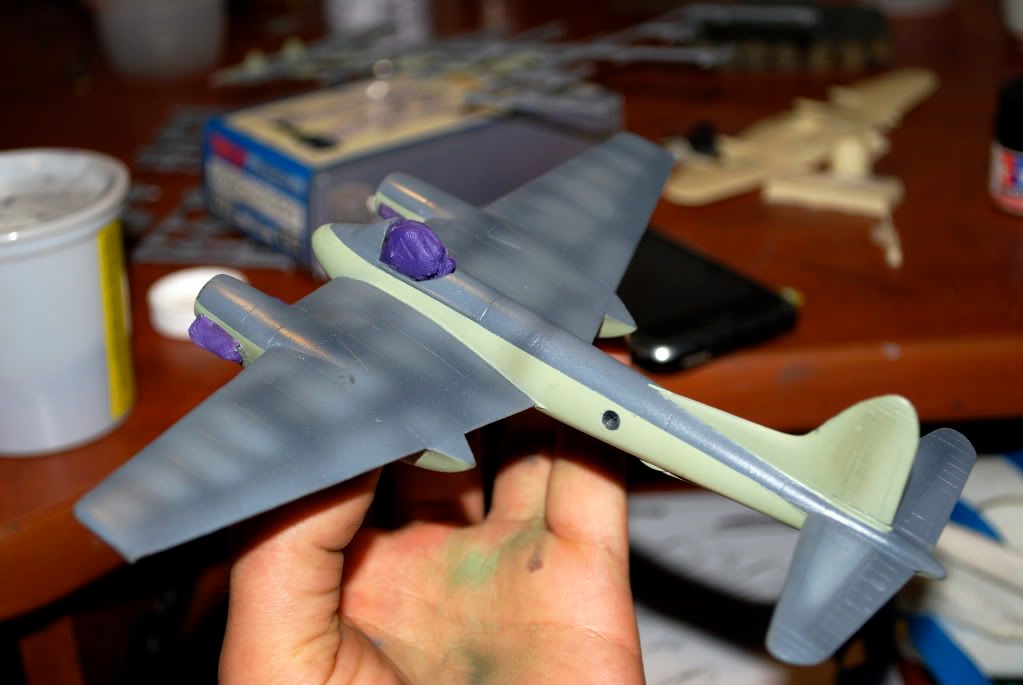
-
-
Not having used it myself, I've heard that Krylon works as an excellent primercoat that you can use to cover any of the original paint remaining on the model. That way it also provides a good base for the actual painting that you will do. I'm actually debating buying a can of black for basecoating my natural metal builds. The problem from Krylon in a spraycan is that the nozzle is not the best (its designed to cover large surfaces, not small detail models) so some have taken to decanting it and then using it in an airbrush. Also its got limited colors available.
Tamiya is probably the best paint for airbrushing static models. Those last three words are key. its formulation makes it very versatile when applying it through an airbrush; you can use a thicker paint or a very thin one and it will go on with very defined properties that make it wonderful to use. It also is acrylic, cleans up really easy and can be masked with little fear of having it torn off when removing the tape.
That said it has several limitations; Its a terrible brush paint. I suffered through it for several years until I bought a airbrush. Its also not the most durable paint; it won't stand up to alot of abuse if you're transforming your model. In reality, with the possible exception of Krylon, few paints will anyway. Certainly none of the major modeling brands like Gunze, Testors, ect, can take that abuse. The most effective way is to use a future gloss coat over top of the tamiya and that will make it much more durable... but its not really the optimum solution. You won't be able to lay down any flat coat or semi gloss either in that situation.
Hope that helps.
If you do a search I reckon you'll find heaps of topics covering this.Do you have any other purpose on this forum except to be annoying? As Far as I can see you aren't a moderator and you aren't being helpful at all.
-
I agree with Chas and Jardann; you want to go with "real models" if you want to develop your skills.
Here would be my suggestion if I wanted to learn how to build, fast. Your first step would be to pick a subject; lets say the P-51 for example. Go buy a good detail book on it, like this one. It will give you a reference to add details. Then start buying kits... start with an easy one a Tamiya 1/72 or 1/48 P-51D, then go to older models like the Monogram or whatever. Then go to specialized resin kits, like the CMR 1/72 P-51H... or something like that. As the difficulty increases, each will teach you something different which you will develop your skills.
Its just a suggestion, but modeling is not an easy hobby. Unless you're a savant, its going to take you at least a year to get your skills up to a point where you will be producing reasonably high quality models.
-
What I'd really like is a brushable flat coat. Future brushes great--but I rarely have need for a gloss coat.
Polly scale flat finish; if you can find it. I've started using it lately from my airbrush where it goes on amazing... and I've heard similar rave reviews from others. I recently used it on this 1/72 Hayate which had a Alclad polished aluminum finish underneath and you can see the difference even with the cruddy cellphone.
-
Two points:
#1 The Mayan Calender doesn't end in 2012; it ends in 2220 according to slashdot and this guy who is an expert in Mayan Religion. (just search for Mayan in the text... its about civil war photographs.)
#2 This thread has convinced me never to read another of 1/1 Low Viz Lurker's posts again. They can be summed up as ridiculously verbose and completely out to lunch.
-
I see, thanks guys, I'll try those suggestions. I'm building the Hobby Base corsair since it was $13 cheaper than the Tamiya one. I'm going to try that one next though, may get the 1/48 version since it's virually the same price as the 1/72 one at LHS.
Both are spectacular kits, easily the best in their respective scales.

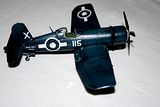
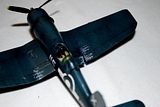
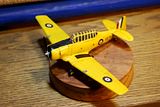
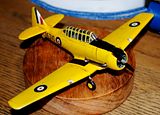
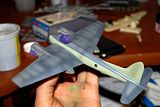
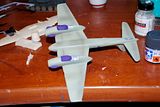
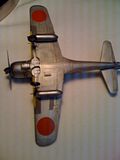
Can anyone recommend a good airbrush?
in The Workshop!
Posted · Edited by Noyhauser
I've got the Iwata Revolution CR and an HP-B. I find the CR (a dual action) does almost everything I ever need it to do; it lays paint down like no other, easy to clean and pretty rugged. Basically at the end of the night I run some lacquer thinner through it, remove the needle and thats' it. I'll give it a thorough cleaning once every month, but I've been negligent about it and it doesn't really affect it. I'll take a photo of it when I get home, its usually just covered in paint.
The Revolution is also reasonable for a Iwata: you can get a used one for 60 dollars, and parts for it run around 20~40 dollars. By comparison the HP-B's nozzle (which I had to replace recently) runs around 60~80 dollars. The only reason why I use the HP-B is for fine details like exhaust stains or freehand camo.. its too fine for putting down large amount of paint. I had a VL and while I like it, I find the CR does everything I need with slightly better performance and easier cleaning.
I could go on singing its praises but I think you get the picture. I've been using mine for two years at least two night a week, even more and its by far the most useful modeling tool I own.